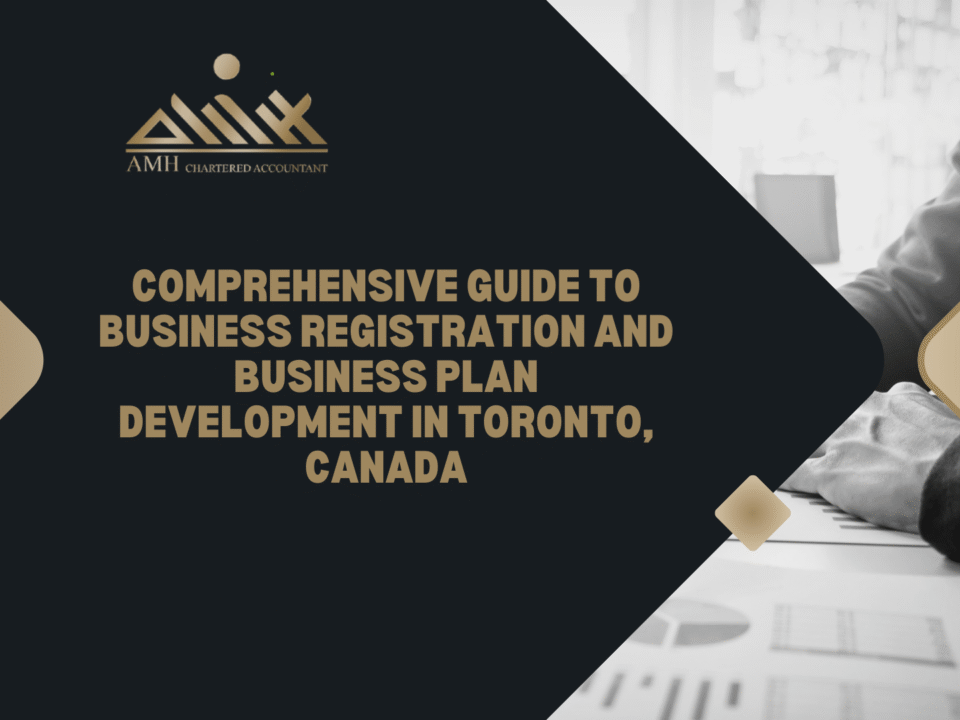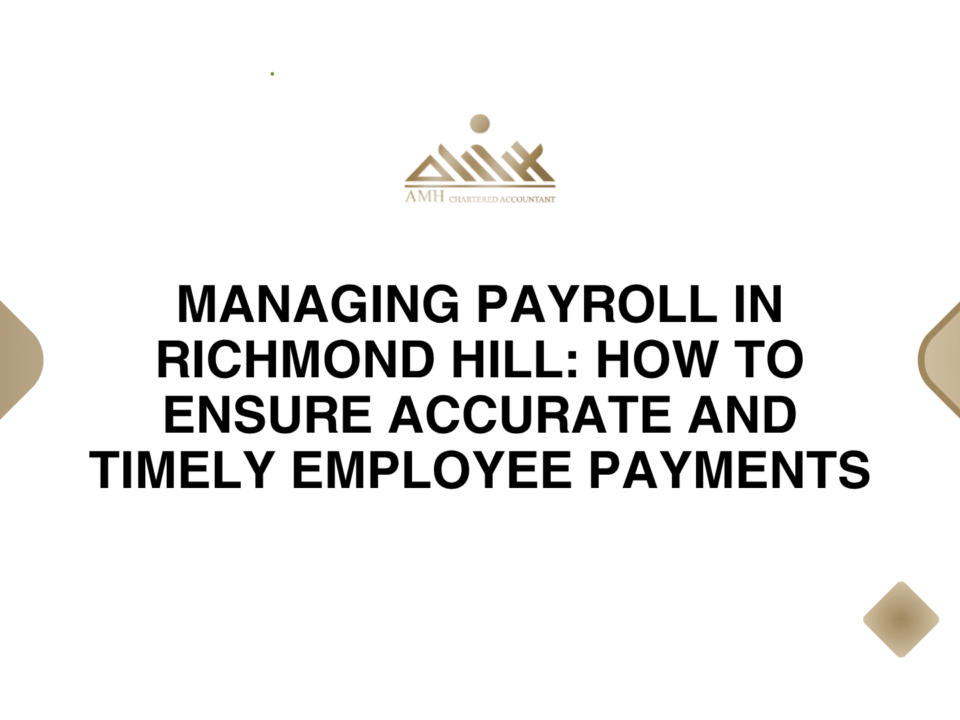
Simplifying Financial Reports for Investors: Speak Their Language
July 10, 2025
How to Calculate Depreciation for Assets Accurately in 2025
July 20, 2025Early Warning Signs in Your Financials That Could Signal a Cash Crisis
For business owners, maintaining healthy cash flow is essential for long-term survival and growth. However, cash flow problems often don’t appear overnight. They usually develop over time and can often be spotted through certain early warning signs in your financial statements. By identifying these signals early, you can take action to prevent a full-blown cash crisis that could jeopardize your business’s future.
At AMH Chartered Professional Accountant, we specialize in helping businesses in Toronto, Milton, Oakville, Hamilton, Kitchener, and Waterloo stay on top of their financial health. In this article, we’ll walk you through the early warning signs of a cash crisis and how to address them before they escalate into serious issues.
Introduction: The Importance of Monitoring Your Financials
Managing cash flow is one of the most crucial aspects of running a successful business. Even profitable companies can experience a cash crisis if they don’t properly monitor their financial health. A cash crisis can occur when a business faces a situation where it doesn’t have enough liquidity to meet its short-term obligations, such as paying bills, suppliers, and employees. This can be caused by poor financial management, unexpected expenses, or slow-paying customers.
By staying vigilant and reviewing your financials regularly, you can spot potential cash flow problems before they spiral out of control. This proactive approach can save your business from unnecessary stress and financial strain.
How a Cash Crisis Can Impact Your Business
A cash crisis can have severe consequences for any business, regardless of its size or industry. The impacts of a cash flow issue can include:
Inability to Pay Suppliers: Failing to meet obligations to suppliers and vendors can result in late fees, damage to vendor relationships, and even supply chain disruptions.
Employee Payroll Problems: Without sufficient cash, you may struggle to pay employees on time, leading to decreased morale and productivity, and potentially losing talent.
Missed Growth Opportunities: Cash flow issues can hinder your ability to invest in new opportunities, such as expanding your business, purchasing new equipment, or marketing initiatives.
Credit Problems: Ongoing cash flow issues can affect your creditworthiness, making it more difficult to secure loans or credit lines in the future.
Addressing early warning signs in your financials is the best way to prevent these problems from occurring.
Key Financial Indicators to Watch for Early Warning Signs
Certain financial indicators can help you spot the signs of a cash crisis early on. By keeping a close eye on these key metrics, you can take steps to resolve issues before they become critical. Below are some of the most common early warning signs:
1. Deteriorating Profit Margins: A Red Flag for Cash Flow
Profit margin is a critical indicator of your business’s financial health. It shows how much profit you’re generating relative to your revenue. If you notice a decline in profit margins over time, it’s a red flag that your business may be facing rising costs, price competition, or inefficiencies in operations.
Impact on Cash Flow: Deteriorating profit margins directly affect your cash flow by reducing the amount of money you have available for reinvestment, paying bills, or covering unexpected costs.
What to Do: To address this issue, analyze your costs and look for areas to cut unnecessary expenses or increase efficiency in your operations. You might also consider adjusting your pricing strategy to improve margins.
2. Declining Accounts Receivable Turnover: Too Many Outstanding Invoices
One of the most common causes of cash flow issues is a slow accounts receivable turnover. If your customers are consistently slow to pay their invoices, your business may experience a delay in cash inflow, even if you are generating revenue.
Impact on Cash Flow: High levels of outstanding accounts receivable indicate that money is tied up in unpaid invoices, leaving you with insufficient liquidity to cover your expenses.
What to Do: Tighten your credit terms, offer early payment discounts to encourage prompt payments, and implement a follow-up system to chase overdue invoices. In extreme cases, consider working with a collections agency or offering payment plans for clients.
3. Increasing Liabilities: Rising Debt and its Impact on Cash Flow
If you’re seeing a rise in liabilities, such as an increasing amount of outstanding loans, credit card debt, or unpaid bills, this could be a sign that your business is relying too heavily on debt financing. High levels of debt increase the pressure on your cash flow, as you must meet your debt obligations while managing daily expenses.
Impact on Cash Flow: As your debt load grows, so do your interest payments, which can drain cash reserves. Eventually, this could lead to a cash shortfall.
What to Do: Review your liabilities regularly and assess whether you can negotiate lower interest rates, consolidate debt, or refinance loans to make payments more manageable. If possible, focus on paying down high-interest debt.
4. Negative Cash Flow: The Most Obvious Warning Sign
Negative cash flow is one of the most direct and concerning early warning signs of a cash crisis. When cash flowing out of your business exceeds the cash coming in, you’re left with a negative cash position. This situation can quickly escalate into a cash crisis if not addressed immediately.
Impact on Cash Flow: A negative cash flow indicates that your business isn’t generating enough cash to cover its expenses, which can lead to the inability to pay bills, employees, and other obligations.
What to Do: Reassess your expenses, tighten your spending, and look for ways to boost revenue through improved sales, more efficient operations, or diversifying your income streams. If needed, consider obtaining a short-term loan or line of credit to help bridge the gap.
5. Excessive Inventory Levels: Cash Tied Up in Stock
While inventory is an asset, excessive inventory can be a liquidity problem. If your business is holding more stock than it can sell, it means that cash is tied up in unsold goods, rather than being available for other business needs.
Impact on Cash Flow: The longer inventory sits unsold, the less cash you have available for operating expenses or investment in other areas of your business.
What to Do: Regularly review your inventory levels and optimize stock management. Consider offering discounts or promotions to move inventory more quickly and free up cash.
6. Delayed Payments to Vendors or Suppliers: Strained Vendor Relationships
Delaying payments to suppliers or vendors is often a sign that your business is struggling with cash flow. While it might temporarily alleviate pressure, this practice can harm your vendor relationships and impact future business opportunities.
Impact on Cash Flow: Vendor relationships may become strained, and suppliers could stop offering favorable payment terms or may refuse to do business with you altogether.
What to Do: Prioritize vendor payments to maintain healthy relationships and consider renegotiating payment terms if needed. You might also explore alternatives like factoring or supplier financing to ease cash flow challenges.
How to Prevent a Cash Crisis by Addressing Financial Warning Signs
By actively monitoring your financials and responding quickly to early warning signs, you can prevent a cash crisis from escalating. Here’s how to address these signs:
Regular Financial Reviews: Schedule frequent financial reviews to track key metrics and identify early signs of trouble.
Cash Flow Forecasting: Use forecasting tools to project your future cash flow and make adjustments to avoid a shortfall.
Cost Control: Be vigilant about controlling unnecessary expenses and focus on increasing efficiency across the business.
Best Practices for Managing Cash Flow
Invoice promptly and follow up on overdue payments to improve your accounts receivable.
Negotiate better payment terms with suppliers to improve cash flow timing.
Maintain an emergency cash reserve to manage unforeseen expenses.
The Role of Financial Forecasting in Avoiding Cash Flow Problems
Financial forecasting helps businesses predict future cash needs and avoid cash flow crises. By regularly forecasting your cash flow, you can anticipate shortfalls and take proactive measures to manage them. A detailed forecast should include:
Expected revenue and payment schedules.
Projected expenses for operating costs, loan repayments, and other obligations.
Seasonal fluctuations or external factors that could impact cash flow.
How AMH Chartered Professional Accountant Can Help
At AMH Chartered Professional Accountant, we specialize in helping businesses monitor their financial health and manage cash flow. Our services include:
Cash flow forecasting: We help businesses create detailed cash flow projections and identify potential risks.
Expense management: Our team can assist with managing costs and optimizing financial operations to improve cash flow.
Financial planning and advisory: We provide strategic financial advice to help businesses navigate cash flow challenges and grow sustainably.
What to Do if You Experience a Cash Crisis
If your business is facing a cash crisis, don’t panic. Address the problem quickly by:
Cutting unnecessary expenses.
Negotiating payment terms with suppliers and creditors.
Exploring financing options, such as lines of credit or short-term loans.
Common Mistakes to Avoid During a Cash Crisis
Ignoring the problem: Procrastinating on addressing cash flow issues will only make them worse.
Relying too heavily on debt: Overusing debt to cover cash shortfalls can create long-term financial problems.
Lack of communication: Keep open lines of communication with vendors, creditors, and employees during financial difficulties.
Conclusion: Proactive Financial Management to Avoid a Cash Crisis
Managing cash flow is a vital aspect of running a successful business. By recognizing the early warning signs of a cash crisis and taking action to address them, you can ensure your business remains financially healthy and resilient. Whether it’s through careful monitoring of financial indicators, effective forecasting, or working with a trusted accounting partner like AMH Chartered Professional Accountant, taking proactive steps will safeguard your business from financial distress.
FAQs
What are the key signs of a cash crisis?
The key signs include deteriorating profit margins, declining accounts receivable turnover, increasing liabilities, negative cash flow, excessive inventory, and delayed payments to vendors.
How can I prevent a cash crisis in my business?
Regularly monitor your financials, implement cash flow forecasting, reduce unnecessary expenses, and maintain healthy relationships with vendors and creditors.
Can AMH help me manage my cash flow?
Yes, AMH Chartered Professional Accountant provides cash flow management services, including forecasting, expense management, and strategic financial planning.




